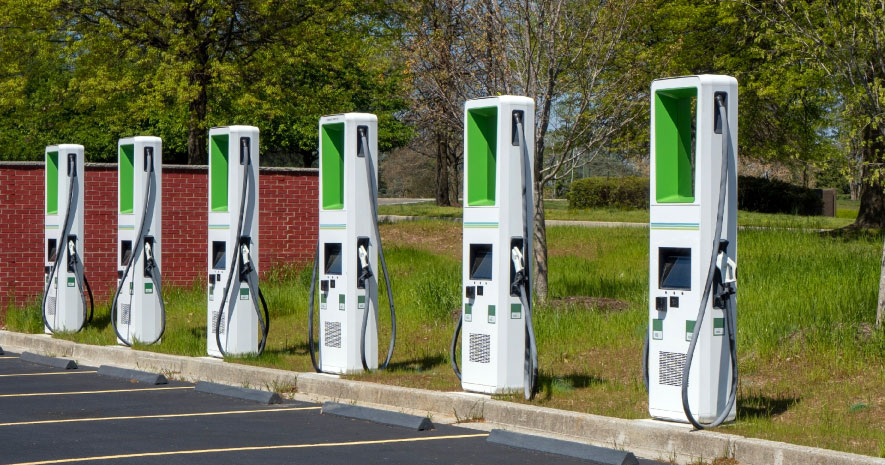Written by Brady Lausch
As consumers continue to demand cleaner transportation, the trend of Electric Vehicles (EV) has become increasingly more relevant. However, a major drawback to electric vehicles still exists. There is not an established charging infrastructure nationwide to support travel with EVs. The Federal Government is making an effort to change this through the National Electric Vehicle Infrastructure (NEVI) grant.
The NEVI grant was established by President Biden and funded through the 2021 Bipartisan Infrastructure law. The goal is to “build-out” a national EV charging network every 50 miles along the interstate highway system to support long-distance travel using electric vehicles. In order to satisfy the full “build-out” goal, the Federal Highway Administration outlined three particular requirements for the EV charging station, which include:
- Being within one mile of an interstate exit or highway intersection
- Have at least four working charging stations capable of charging simultaneously
- Each charging station must have a minimum power capability of 150 kW (600 kW per location)
The Federal Government has given five billion dollars to fund the National Electric Vehicle Infrastructure program. Every U.S. state and territory has access to these funds as long as they propose a plan and submit it to the Federal Highway Administration for approval. The Pennsylvania Department of Transportation submitted its plan on September 14, 2022 and gained approval on October 12, 2022. A total of 171.5 million dollars has been granted to Pennsylvania to be disbursed over the next five years. In the 2022 Federal fiscal year, 25.4 million dollars will be allocated to Pennsylvania, with 36.5 million dollars granted for the following four years. As applications will be opening shortly, there are five key points that anyone looking to apply for NEVI grant funding should know.
Eligible Entities and Projects
PennDOT’s goal is to disperse all the grant funding to applicants. They do not plan to use any grant money to build qualified charging stations personally. This means the application is open to a wide variety of entities. Public sector entities, such as municipalities, incorporated nonprofits, and for-profit businesses are eligible to apply.
While a wide variety of applicants are eligible to apply, there are some requirements for eligible projects. PennDOT has stated that funding will only be distributed for projects “directly related to the charging of a vehicle and only to support EV charging infrastructure that is open to the public or authorized commercial motor vehicle operators from more than one company.” The charging stations must be available to the public 24 hours a day, seven days a week. They also are required to accept contactless payment methods for all major debit/credit cards. Chargers must also display the base electricity price to charge in $/kWh. For a site to be eligible, it must have secure communications with charging networks. It is also important to note that once the grant is received, the charging station must be operational for at least five years, or the money received will need to be paid back.
Selection Criteria
There are multiple criteria that are considered when deciding which applicants will receive the PennDOT NEVI funding. The criteria are grouped into the highest priority, second priority, and third priority. The three criteria included in the highest priority grouping include location, site readiness, and future-proofing.
Location is the most important factor for PennDOT when deciding between applicants. There are three different priority levels for locations. Priority I is within the 50-mile interval outlined by the Federal Highway Administration to achieve fully “built-out” status. Priority II is locations closer than fifty miles to build redundancies into the infrastructure. Priority III are locations that already have an existing NEVI-qualifying EV charging site. PennDOT will first approve Priority I locations applications, then move down to Priority II and Priority III. In order to help applicants better understand the location requirement and availability, PennDOT has put together an interactive map. This map can be filtered by interstate and will show locations based on priority, so potential applicants can easily find Priority I locations that are in need of EV charging stations. This map can be found on PennDOT’s website under Priority Projects locations or by clicking NEVI Interactive Map. If there are multiple locations that an entity is interested in, a separate application must be filed for each potential location.
Site readiness is another high priority factor that PennDOT considers when deciding on applicants. There are three main elements PennDOT is looking at when evaluating site readiness. These include whether there is already power availability, if the site needs to be developed or if there is a need for environmental clearance, and if there are existing agreements/partnerships in place to be able to build a charging station. The last high priority factor PennDOT outlines is future growth possibilities for the location. PennDOT will ask questions such as, Is there an opportunity to add additional ports or the ability to accommodate heavy-duty vehicles in the future? With the potential for rapid growth in the EV industry, PennDOT wants to be ahead of the curve when it comes to state EV charging infrastructure. The ability to add additional power or ports, along with accommodating heavy-duty vehicles, will significantly enhance the chance of receiving funding.
Second priority factors address sustainability and opportunity for economic development. PennDOT prefers locations that can use renewable energy sources and strategies and involve local and small businesses. While the second priority factors are not as vital as the highest priority factors, they still should be considered when putting together a proposal for PennDOT. The third priority factor is cost. While PennDOT does not want cost to be a deciding factor on who gets funding, it is still important to consider. There is only a limited amount of grant money available, so the amount of funding requested is a factor in determining which applicants receive grant funding.
Eligible and Ineligible Costs
It is important to understand the costs that are eligible under the NEVI grant. The federal guidelines are particular. Any costs related to the acquisition, installation, and network connection of EV charging station, proper operations and maintenance of EV charging stations, and long-term EV charging station data sharing are eligible. Pennsylvania specifically outlines eligible and ineligible costs by saying planning, hardware, and construction costs, as well as fixed operational and maintenance costs are eligible costs. Fixed operational and maintenance costs include five-year fixed networking and data cost and five-year fixed warranty cost. Ineligible costs include variable operational and maintenance costs. This includes electricity, insurance, and other recurring business costs, such as staffing. The grant will cover up to 80% of eligible project costs. The applicant must match at least 20% of the eligible project costs to receive the grant.
NEVI Anticipated Timeline
Since Pennsylvania will receive the grant money over the next five years, the distribution of grant money to an applicant will occur in multiple rounds. PennDOT has released the tentative timeline for the first round of funding. According to this tentative timeline, applications will be due in mid-March 2023. Conditional awards will be granted in mid-May, with final awards coming in mid-July.
The first round of funding will focus on the interstates in an effort to build the national infrastructure outlined in the federal plan. When the final awards are released in July, the second round of funding will open for applicants, which will focus on all other alternative fuel locations. If an entity is rejected in the first round of applications, it is highly suggested that they continue to apply in the following rounds.
How to prepare
PennDOT has outlined the suggested steps for applicants to prepare for the Grant application process.
- Create a keystone login. Applicants will need a keystone login in order to apply for the NEVI grant.
- Familiarize yourself with the NEVI program. It is important to research grant funding on the federal level as well as the Pennsylvania level.
- Establish a NEVI grant application team now. If applicants are able to begin forming their team the thinking about possible partnerships, this will help applicants stay one step ahead of the rest of the applicant pools.
- Select sites and coordinate with utilities. Applicants must begin by picking a potential location for their charging station. This will allow an applicant to assess the potential costs associated with their chosen location. It is also essential to consider the existing utility infrastructure available and begin to coordinate with the utility provider to understand the potential installation and service costs associated with possible sites.
For any entities interested in applying for the NEVI grant, now is the time to begin the planning process. Additional information regarding the grant program and PennDOT’s plan can be found on the PennDOT website: National Electric Vehicle Infrastructure (NEVI) Formula Program (pa.gov).





